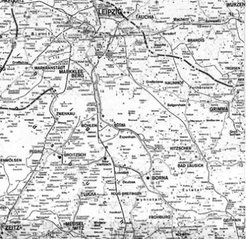Political Economy and Political Clientelism in the Agricultural and Industrial Region South of Leipzig
Project Summary

The area south of the city of Leipzig provides dramatic illustrations of some of the most characteristic developments in Eastern Germany over the last century and a half.* These developments - which have been affected by general trends in the world economy and by the widely varying policies of a series of national governments - include, especially, (1) the rise and fall of the carbo-chemical industry and (2) the liberalization, collectivization, and re-privatization of agricultural production. Both have reshaped the physical environment and restructured the lives of the people living within it. Local actors have, in turn, administered, enforced, resisted, or otherwise responded to changing agricultural and industrial policies in ways which have themselves contributed to the course of events. This project focuses on the implications of the changing regional political economy for property relations. Property relations are understood in a broad sense of the term to include the variables governing actors' access to resources and their ability to control the use of these resources under specific social, political, and economic conditions. Changing property relations are being investigated using ethnographic, sociological, and historical methods. The temporal focus is on the transition in property relations after 1945 and after 1990, but these transitional periods must often be viewed in a larger historical framework.
*In this project description, "Eastern Germany" refers to the territories which used to make up the German Democratic Republic and which now consist of the federal states of Mecklenburg-Western Pomerania, Brandenburg, Berlin, Thuringia, Saxony-Anhalt, and Saxony.
The Field Site
The Südraum Leipzig, or Southern Region of Leipzig, corresponds roughly to the contemporary rural county called the Landkreis Leipziger Land. The Southern Region is located in northwest Saxony within a triangle formed by the city of Leipzig in the north, the town of Zeitz in the southwest and the town of Geithain in the southeast.* The more narrow regional focus of this study is the area between the two local centers of Groitzsch and Borna - an area with the characteristic mix of agriculture, coal mining, power plants, chemical installations, and small businesses.
The Southern Region of Leipzig is a fertile and remarkably flat landscape. Only at its southern extremity do the meadowlands give way to foothills. It is crossed by the Weisse Elster and the Pleisse, two small rivers which flow from south to north. Up until the late nineteenth century, agriculture was supplemented only by processing industries based on agricultural products or available natural resources - breweries, flour mills, and brickyards. With the exception of a few larger noble estates, there was a preponderance of small to medium-sized farms, which had, with the liberal reforms of the mid-nineteenth century, become business enterprises catering to growing urban populations. In the late nineteenth century, new technologies made possible the exploitation of abundant reserves of brown coal or lignite. By the early twentieth century, coal was acquired in expanding surface mines, which have left large scars upon the earth's surface. Coal mining was accompanied by the arrival of industrial workers, the growth of new residential complexes, and the rise of the carbo-chemical and energy industries in a regional economy which continued to include agricultural production.
* The Southern Region of Leipzig is in the federal state of Saxony but borders on both Saxony-Anhalt and Thuringia. Zeitz lies just over the border in Saxony-Anhalt.
